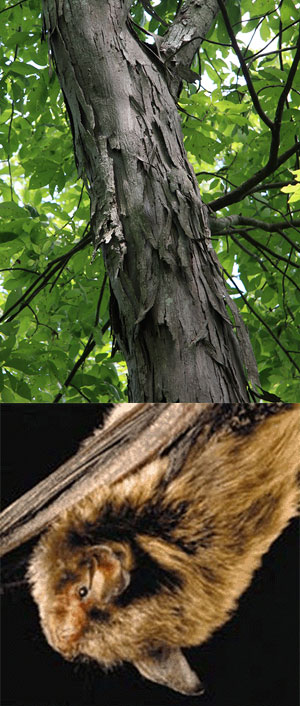New Haven
Connections
Written by Emma Stuhl
Human history is intimately tied to the history of the land in New Haven. The physical and ecological landscapes have determined where people have found or grown food and other life necessities, where people have settled, and what challenges communities have faced. Today, with goods coming into people’s lives from around the world, we are connected to a much larger area of land. Yet, we find that our connections to our homes are as strong as ever when we take the time to discover how the land and the surrounding ecosystems support us.
Let’s explore a remarkable story that highlights these connections in New Haven today. It all begins with the shagbark hickory, Carya ovata, a deciduous tree that grows in the warmer parts of Vermont and that stands out because of its shaggy, peeling bark. Since the shagbark hickory is at the edge of its range in Vermont, it thrives best on relatively nutrient-rich soils. These factors come together nicely in New Haven, where much of the soil is quite fertile and where Lake Champlain holds the summer’s heat into the depths of winter and thus moderates the region’s temperatures. New Haven’s south-facing hills also create warmer microclimates where shagbarks grow well, and calcium-rich bedrock feeds some of the town’s soils from below.

Shagbark Hickory
Photo credit Jane Shelby Richardson Wikimedia
“Indiana Bat (Myotis Sodalis)”
U.S. Fish and Wildlife Service
We introduce our second character, the Indiana bat, Myotis sodalis, a tiny mammal that weighs one quarter of an ounce, the same weight as three pennies. This federally endangered bat winters in caves in huge numbers, so if something goes wrong in one cave, it has an enormous impact on the population. Since 2007, bats, in general, have been dying in large numbers from White Nose syndrome. White Nose syndrome is an invasive fungus that grows into the bats’ noses and digests the nose tissue while the bats hibernate through the winter. When the fungus infects the bats, they often wake from their hibernation and fly out of the cave, into wintery conditions that are too extreme for them to survive.
Breeding female Indiana bats spend the summers in small colonies, raising one baby each. They roost beneath the peeling bark of trees. This bark might be on a dead tree, on a really old tree, or on a shagbark hickory, which peels a lot once trees are mid-sized.
It turns out that Indiana bat mothers raise their young in shagbark hickories in New Haven. In fact, there are landowners in town that work with state wildlife biologists to improve the Indiana bat habitat on their property.
Indiana bats, and other bats, provide important ecosystem services in Vermont. Indiana bats can eat up to half their body weight in mosquitoes, moths, beetles, and midges each night. In tropical and desert ecosystems, bats are also important pollinators. It may be time for New Haven to celebrate this special resident by adopting a new mascot.
This story is just one example of how the diverse features of the New Haven landscape come together in wild areas, but also in residents’ backyards. Whether through soil nutrients feeding crops, wetlands purifying the water we drink and swim in, or bats eating bothersome insects, our lives are intimately connected to the landscapes in which we live.
To learn more about Indiana bat habitat in New Haven, check out this PBS podcast which features a New Haven resident: